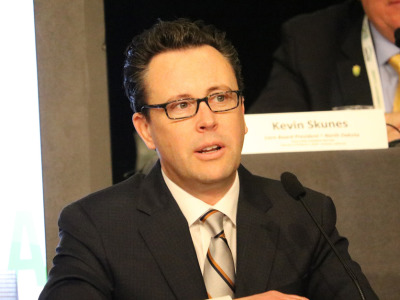Stakeholders from all sides of the Renewable Fuel Standard cautioned federal regulators Tuesday about moving forward with their proposed multiyear set of blending targets for the nation’s biofuel mandate.
The hearing held by the Environmental Protection Agency offered the first chance to provide official input on the volume targets EPA rolled out in December that would set the amount of gallons blended into the nation’s fuel supply for 2020, 2021, and 2022. The agency also proposed a new framework for considering small refinery exemptions — waivers offered to facilities demonstrating possible economic harm from complying with the annual mandate — and proposed denying 65 pending applications.
Biofuel groups were quick to praise several key aspects of the December rollout, namely the 2022 Renewable Volume Obligations, which leave room for the statutory 15 billion gallons of conventional biofuel blending and begin the process of addressing a requirement from a previous court case when the agency was ordered to put another 500 million gallons into future blending targets due to issues with previous rules.
Growth Energy CEO Emily Skor welcomed the “forward-looking actions that underscore the critical role biofuels play in decarbonizing the transportation sector” and Renewable Fuels Association President and CEO Geoff Cooper said the majority of the proposed rule “represents an important and long-awaited step toward restoring order, integrity and stability to the Renewable Fuel Standard program.”
However, biofuel interests hammered EPA for its decision to propose cutting the 2020 RVO — which was finalized in 2019 — due to the drop in demand fueled by the COVID-19 pandemic.
American Coalition for Ethanol CEO Brian Jennings called the 2020 revision “legally dubious” and criticized the agency’s “ongoing obsession with maximum compliance flexibility.”
 Brian Jennings, ACE“This approach essentially shifts more of the pandemic burden from refiners to ethanol producers and farmers by allowing gallons already sold to be counted against 2022 volumes,” Jennings said.
Brian Jennings, ACE“This approach essentially shifts more of the pandemic burden from refiners to ethanol producers and farmers by allowing gallons already sold to be counted against 2022 volumes,” Jennings said.Instead of cutting the 2020 RVO, biofuel groups suggested EPA use a mechanism in the law to call for a certain percentage of biofuels in the fuel supply rather than flatly cutting the amount of gallons required for blending. As National Corn Growers Association President Chris Edgington put it, the groups want EPA to “respect actual fuel production numbers for 2020 and 2021.”
“RFS obligations already self-adjust for declines in fuel consumption, as occurred in 2020,” he added. “Even if EPA believes additional correction is needed, the 2020 and 2021 proposals cut far beyond actual numbers.”
For its part, the National Biodiesel Board offered thoughts from a handful of commenters, including Kate Shenk, the group’s director of regulatory affairs. She offered caution as EPA considered a change to its definition of “produced from renewable biomass,” saying the agency should “take a closer look to see how this change may impact renewable fuels already in commerce that are making great strides in the hard-to-decarbonize sector.”
Looking for the best, most comprehensive and balanced news source in agriculture? Our Agri-Pulse editors don't miss a beat! Sign up for a free month-long subscription by clicking here.
Paul Machiele, the director of EPA’s Fuel Programs Center who was monitoring the meeting, offered rare feedback to a presenter’s comments, agreeing with Shenk that “we want to make sure we don’t create new problems as we try to fix existing ones.”
Oil industry speakers were also on hand at the hearing, where they argued for modest volume targets and a recognition of the “unique and unprecedented” year that was 2020, as American Petroleum Institute’s Patrick Kelly put it. Kelly, API’s senior policy adviser, said the group “has generally not supported retroactive changes” but called the 2020 cut “necessary to address this unusual situation.”
API and the American Fuel and Petrochemical Manufacturers also offered divergent SRE opinions. Kelly argued the proposed sweeping denial and “long overdue reinterpretation” of SRE requirements would “help restore a level playing field for competing refiners in the marketplace.”
AFPM’s Mike Burnside, however, said his group was concerned by the blanket denial, citing a 2021 Supreme Court ruling that overturned a Circuit Court decision requiring continuity in a facility’s relief; that ruling, however, did not overturn other aspects of the lower court’s decision, leaving EPA to consider a pair of legal opinions as it offers a new examination of what it should take to receive an SRE.
“That Supreme Court decision cannot be ignored,” Burnside said. “These pending SRE petitions were scored by (the Department of Energy), but we do not know the aggregation of these scores. Did DOE recommend relief for any pending SRE petition? EPA should be far more transparent to all stakeholders concerning its work with DOE in this area.”
By law, EPA was supposed to have the RVOs finalized by the end of November. Having already missed that deadline, the agency is currently expected to finalize the pending rulemaking in early 2022.
For more news, go to www.Agri-Pulse.com.


